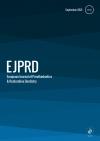European Journal of Prosthodontics and Restorative Dentistry
Accuracy, Reliability and Clinical Implications of Static Compared to Quantifiable Occlusal Indicators
Abstract
Objective: This literature review summarizes the properties, advantages, limitations, and clinical implications of employing static occlusal indicators compared to quantifiable digital occlusal indicators during occlusal adjustments. Method: An electronic database search of dental literature was carried out in PubMed/MEDLINE using the key words: Occlusal Indicators, Occlusal Assessment, Static, Reliability, Dynamic, Repeatability, Validity and Clinical Accuracy. A total of 231 papers were isolated, with 129 papers considered for review. Results: The included papers were grouped by Static and Dynamic Occlusal indicators. The numbers of papers in the Static Group was extremely low (only 20 papers) compared to The Dynamic group (T-Scan: 89; Dental Prescale: 28; Intraoral
Scanners:17). Conclusion: Little evidence supports the use of static occlusal indicators due to their high degree of subjectivity required during implementation. However, much scientific evidence supports the use of T-Scan, as it measures relative occlusal forces and timing objectively, accurately, and repeatedly. For the improvement of Occlusal Practice, Subjective Interpretation using Static occlusal indicators should be replaced with digital ones for objective measurements. Clinical Relevance: The computerized occlusal analysis system is well studied and has the capacity to provide precise time and force sequencing information to objectively evaluate occlusal contacts for improved treatment outcome.
Keywords
Objective Evaluation
Digital Workflow
Occlusal Analysis
Digital Occlusal Indicators
Static Occlusal Indicators
T-Scan
Authors
Sarah Qadeer, Daniel Edelhoff, Hans VanPelt
Articles from this issue
 Free Access
Free Access No Access
No Access Full Access
Full Access


